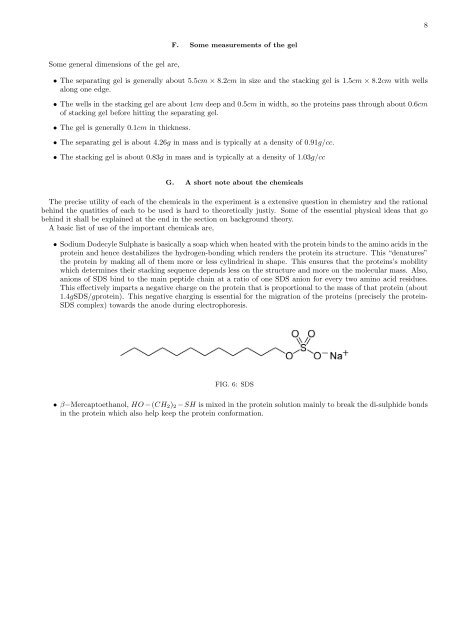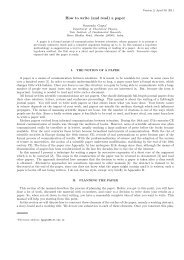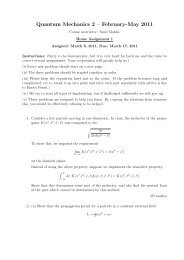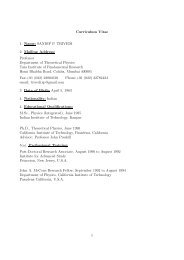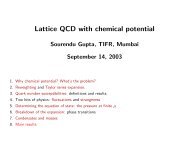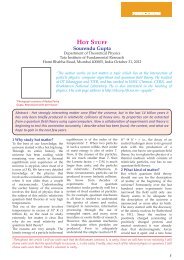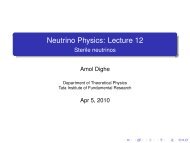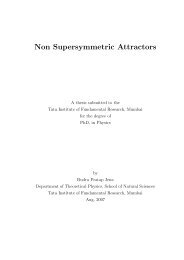A report on an experiment I did of doing electrophoresis with proteins
A report on an experiment I did of doing electrophoresis with proteins
A report on an experiment I did of doing electrophoresis with proteins
You also want an ePaper? Increase the reach of your titles
YUMPU automatically turns print PDFs into web optimized ePapers that Google loves.
8<br />
Some general dimensi<strong>on</strong>s <strong>of</strong> the gel are,<br />
F. Some measurements <strong>of</strong> the gel<br />
• The separating gel is generally about 5.5cm × 8.2cm in size <strong>an</strong>d the stacking gel is 1.5cm × 8.2cm <strong>with</strong> wells<br />
al<strong>on</strong>g <strong>on</strong>e edge.<br />
• The wells in the stacking gel are about 1cm deep <strong>an</strong>d 0.5cm in width, so the <strong>proteins</strong> pass through about 0.6cm<br />
<strong>of</strong> stacking gel before hitting the separating gel.<br />
• The gel is generally 0.1cm in thickness.<br />
• The separating gel is about 4.26g in mass <strong>an</strong>d is typically at a density <strong>of</strong> 0.91g/cc.<br />
• The stacking gel is about 0.83g in mass <strong>an</strong>d is typically at a density <strong>of</strong> 1.03g/cc<br />
G. A short note about the chemicals<br />
The precise utility <strong>of</strong> each <strong>of</strong> the chemicals in the <strong>experiment</strong> is a extensive questi<strong>on</strong> in chemistry <strong>an</strong>d the rati<strong>on</strong>al<br />
behind the quatities <strong>of</strong> each to be used is hard to theoretically justiy. Some <strong>of</strong> the essential physical ideas that go<br />
behind it shall be explained at the end in the secti<strong>on</strong> <strong>on</strong> background theory.<br />
A basic list <strong>of</strong> use <strong>of</strong> the import<strong>an</strong>t chemicals are,<br />
• Sodium Dodecyle Sulphate is basically a soap which when heated <strong>with</strong> the protein binds to the amino acids in the<br />
protein <strong>an</strong>d hence destabilizes the hydrogen-b<strong>on</strong>ding which renders the protein its structure. This “denatures”<br />
the protein by making all <strong>of</strong> them more or less cylindrical in shape. This ensures that the <strong>proteins</strong>’s mobility<br />
which determines their stacking sequence depends less <strong>on</strong> the structure <strong>an</strong>d more <strong>on</strong> the molecular mass. Also,<br />
<strong>an</strong>i<strong>on</strong>s <strong>of</strong> SDS bind to the main peptide chain at a ratio <strong>of</strong> <strong>on</strong>e SDS <strong>an</strong>i<strong>on</strong> for every two amino acid residues.<br />
This effectively imparts a negative charge <strong>on</strong> the protein that is proporti<strong>on</strong>al to the mass <strong>of</strong> that protein (about<br />
1.4gSDS/gprotein). This negative charging is essential for the migrati<strong>on</strong> <strong>of</strong> the <strong>proteins</strong> (precisely the protein-<br />
SDS complex) towards the <strong>an</strong>ode during <strong>electrophoresis</strong>.<br />
FIG. 6: SDS<br />
• β−Mercaptoeth<strong>an</strong>ol, HO −(CH 2 ) 2 −SH is mixed in the protein soluti<strong>on</strong> mainly to break the di-sulphide b<strong>on</strong>ds<br />
in the protein which also help keep the protein c<strong>on</strong>formati<strong>on</strong>.


